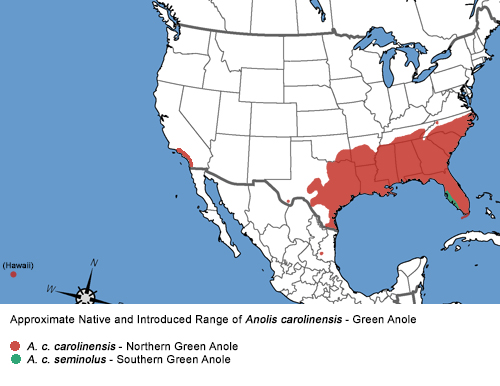Green Anole - Anolis carolinensis
(Voigt, 1832)
(Chameleon)
Description • Taxonomy • Species Description • Scientific Name • Alt. Names • Similar Herps • References • Conservation Status
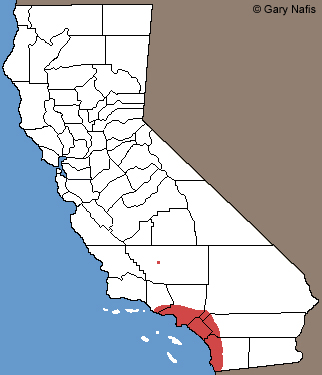 Click on the map for a topographical view
Click on the map for a topographical view| Red: Areas within which this non-native species has been observed and could be established. This anole appears to be expanding its range in California and is very likely to be found in other areas not shown here. If you find a Green Anole in a place in California that is not shown in red on the map above, please email me and let me know where it was found. Map with California County Names List of Non-Native Reptiles and Amphibians Established in California |
More Pictures:
This species has been introduced into California. It is not a native species. |
||||||||||||||||||||||||||||||||||||||||||||||||||
 |
||||||||||||||||||||||||||||||||||||||||||||||||||
| Adult, San Diego Zoo, San Diego County © Stephen Custance-Baker | ||||||||||||||||||||||||||||||||||||||||||||||||||
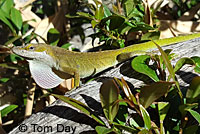 |
 |
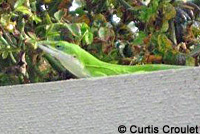 |
||||||||||||||||||||||||||||||||||||||||||||||||
| Adult male displaying his dewlap, San Diego County © Tom Day | Adult, Redhawk area of Temecula, Western Riverside County, 2010, from a population of anoles observed since 1993. © Curtis Croulet |
|||||||||||||||||||||||||||||||||||||||||||||||||
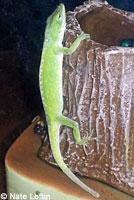 |
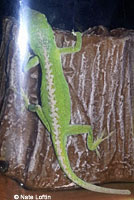 |
 |
||||||||||||||||||||||||||||||||||||||||||||||||
| Adult, Chino Hills, San Bernardino County © Nate Loftin | Adult found in a Newport Beach, Orange County, backyard. The photographer discovered that this lizard was one of three released in her neighbor's yard. If these lizards survive and breed, they could become established in the neighborhood. That's why it is a bad idea (and against the law) to release non-native reptiles. | |||||||||||||||||||||||||||||||||||||||||||||||||
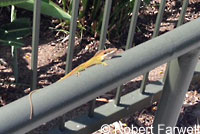 |
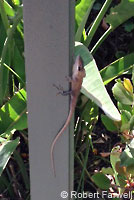 |
 |
||||||||||||||||||||||||||||||||||||||||||||||||
| Adults from San Diego a few miles northeast of Balboa Park. © Robert Farwell |
Adult, San Diego Zoo © Walter Ray-Dulany |
|||||||||||||||||||||||||||||||||||||||||||||||||
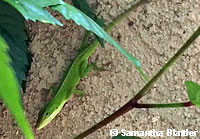 |
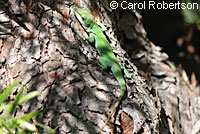 |
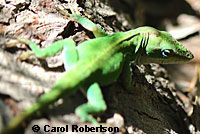 |
||||||||||||||||||||||||||||||||||||||||||||||||
| Adult, Carlsbad, San Diego County © Samantha Blattler |
Adults, Huntington Beach, Orange County © Carol Robertson | |||||||||||||||||||||||||||||||||||||||||||||||||
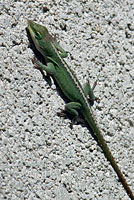 |
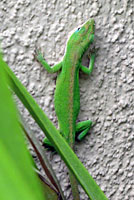 |
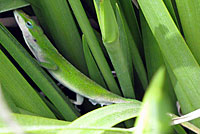 |
||||||||||||||||||||||||||||||||||||||||||||||||
| Adults from Tustin, Orange County | ||||||||||||||||||||||||||||||||||||||||||||||||||
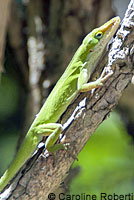 |
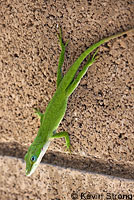 |
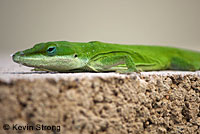 |
||||||||||||||||||||||||||||||||||||||||||||||||
| Adult, San Diego Zoo, San Diego County © Caroline Roberti | Adult from Tustin, Orange County © Kevin Strong | |||||||||||||||||||||||||||||||||||||||||||||||||
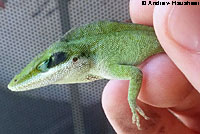 |
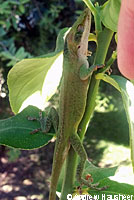 |
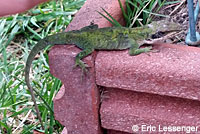 |
||||||||||||||||||||||||||||||||||||||||||||||||
| Adult male showing the dorsal crest, Laguna Hills, Orange County © Andrew Hausheer |
Adult, Fountain Valley, Orange County © Eric Lessenger |
|||||||||||||||||||||||||||||||||||||||||||||||||
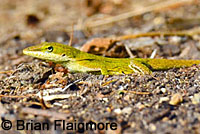 |
 |
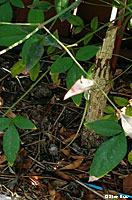 |
||||||||||||||||||||||||||||||||||||||||||||||||
| Adult, Balboa Park, San Diego County © Brian Flaigmore |
Tiny juvenile, Chula Vista, San Diego County © Stan Budz | This picture shows how well this lizard can blend in with its surroundings. Often they turn brown when they're on a brown surface, but this one remains green which makes it look like one of the leaves and vines. © Stan Budz | ||||||||||||||||||||||||||||||||||||||||||||||||
 |
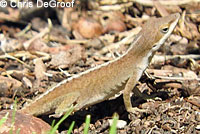 |
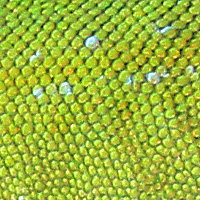 |
||||||||||||||||||||||||||||||||||||||||||||||||
| Adult, San Diego County © Chris DeGroof |
Brown phase adult, San Diego County © Chris DeGroof |
Green Anoles, genus Anolis, have small granular scales. |
||||||||||||||||||||||||||||||||||||||||||||||||
| Habitat | ||||||||||||||||||||||||||||||||||||||||||||||||||
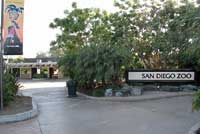 |
||||||||||||||||||||||||||||||||||||||||||||||||||
| One of the first places this species was known to have been established in California was at the San Diego Zoo in Balboa Park, San Diego County. | ||||||||||||||||||||||||||||||||||||||||||||||||||
| Green Anoles From Outside California | ||||||||||||||||||||||||||||||||||||||||||||||||||
 |
||||||||||||||||||||||||||||||||||||||||||||||||||
| Green phase adult Monroe County, Florida | ||||||||||||||||||||||||||||||||||||||||||||||||||
 |
||||||||||||||||||||||||||||||||||||||||||||||||||
| Adult in brown phase, Nueces County, Texas | ||||||||||||||||||||||||||||||||||||||||||||||||||
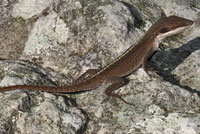 |
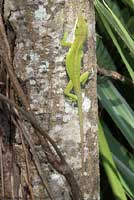 |
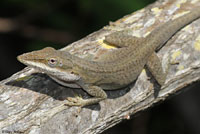 |
||||||||||||||||||||||||||||||||||||||||||||||||
| Adult, Jasper County, Texas | Adult, Jefferson Parish, Louisiana | Adult, Miami-Dade County, Florida | ||||||||||||||||||||||||||||||||||||||||||||||||
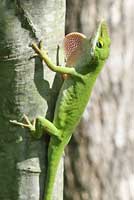 |
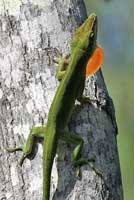 |
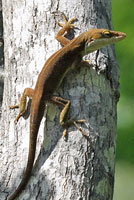 |
||||||||||||||||||||||||||||||||||||||||||||||||
| Adult male displaying distended pink dewlap, Galveston County, Texas | Adult male displaying distended pink dewlap (left) in green phase, and moments later, in brown phase (right) Galveston County, Texas |
|||||||||||||||||||||||||||||||||||||||||||||||||
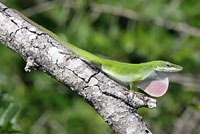 |
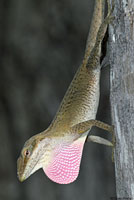 |
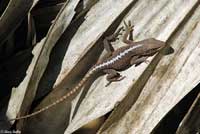 |
||||||||||||||||||||||||||||||||||||||||||||||||
| Adult male displaying distended pink dewlap, Galveston County, Texas | Adult male, Miami-Dade County, Florida | Adult, Jefferson Parish, Louisiana | ||||||||||||||||||||||||||||||||||||||||||||||||
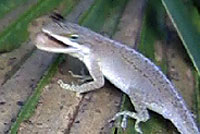 |
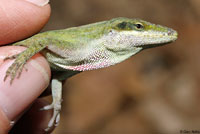 |
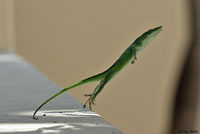 |
||||||||||||||||||||||||||||||||||||||||||||||||
| A light-phase green anole tried to catch a fly, but failed, Volusia County, Florida | Adult male, Liberty County, Florida | Adult jumping, Broward County, Florida | ||||||||||||||||||||||||||||||||||||||||||||||||
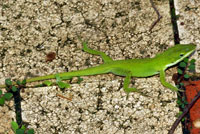 |
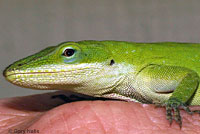 |
|||||||||||||||||||||||||||||||||||||||||||||||||
| Adult, Travis County, Texas | ||||||||||||||||||||||||||||||||||||||||||||||||||
| Short Videos | ||||||||||||||||||||||||||||||||||||||||||||||||||
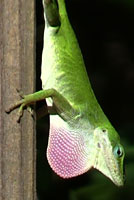 |
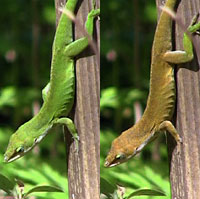 |
 |
||||||||||||||||||||||||||||||||||||||||||||||||
| A male green anole in Chambers County Texas displays his pink dewlap. | A male green anole in Chambers County Texas quickly changes his color from green to brown after he jumps onto a wooden post. | A light-phase green anole in Florida tries to catch a fly, but fails. | ||||||||||||||||||||||||||||||||||||||||||||||||
|
||||||||||||||||||||||||||||||||||||||||||||||||||
|
||||||||||||||||||||||||||||||||||||||||||||||||||
|
The following conservation status listings for this animal are taken from the July 2025 State of California Special Animals List and the July 2025 Federally Listed Endangered and Threatened Animals of California list (unless indicated otherwise below.) Both lists are produced by multiple agencies every year, and sometimes more than once per year, so the conservation status listing information found below might not be from the most recent lists, but they don't change a great deal from year to year.. To make sure you are seeing the most recent listings, go to this California Department of Fish and Wildlife web page where you can search for and download both lists: https://www.wildlife.ca.gov/Data/CNDDB/Plants-and-Animals. A detailed explanation of the meaning of the status listing symbols can be found at the beginning of the two lists. For quick reference, I have included them on my Special Status Information page. If no status is listed here, the animal is not included on either list. This most likely indicates that there are no serious conservation concerns for the animal. To find out more about an animal's status you can also go to the NatureServe and IUCN websites to check their rankings. Check the current California Department of Fish and Wildlife sport fishing regulations to find out if this animal can be legally pursued and handled or collected with possession of a current fishing license. You can also look at the summary of the sport fishing regulations as they apply only to reptiles and amphibians that has been made for this website. |
||
| Organization | Status Listing | Notes |
| NatureServe Global Ranking | ||
| NatureServe State Ranking | ||
| U.S. Endangered Species Act (ESA) | none | |
| California Endangered Species Act (CESA) | none | |
| California Department of Fish and Wildlife | none | |
| Bureau of Land Management | none | |
| USDA Forest Service | none | |
| IUCN | ||
|
|
||
Return to the Top
© 2000 -


